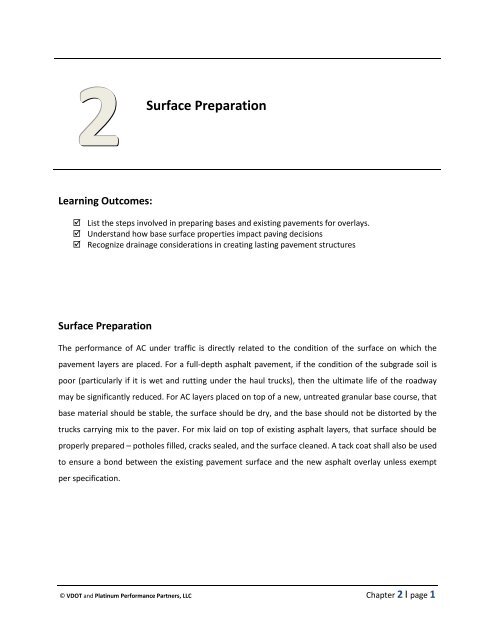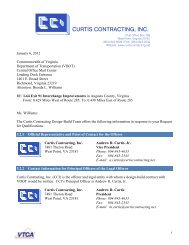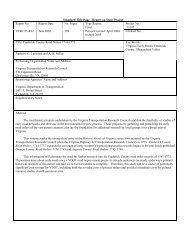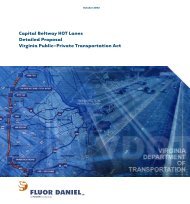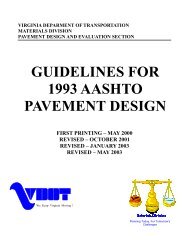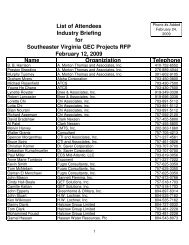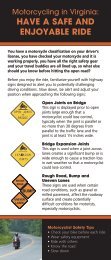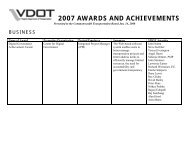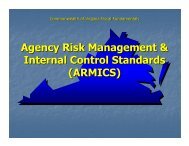Create successful ePaper yourself
Turn your PDF publications into a flip-book with our unique Google optimized e-Paper software.
2SurfacePreparationLearning Outcomes: List the steps involved in preparing bases and existing pavements for overlays. Understand how base surface properties impact paving decisions Recognize drainage considerations in creating lasting pavement structuresSurface PreparationThe performance of AC under traffic is directly related to the condition of the surface on which thepavement layers are placed. For a full-depth asphalt pavement, if the condition of the subgrade soil ispoor (particularly if it is wet and rutting under the haul trucks), then the ultimate life of the roadwaymay be significantly reduced. For AC layers placed on top of a new, untreated granular base course, thatbase material should be stable, the surface should be dry, and the base should not be distorted by thetrucks carrying mix to the paver. For mix laid on top of existing asphalt layers, that surface should beproperly prepared – potholes filled, cracks sealed, and the surface cleaned. A tack coat shall also be usedto ensure a bond between the existing pavement surface and the new asphalt overlay unless exemptper specification.© VDOT and Platinum Performance Partners, LLC <strong>Chapter</strong> 2 І page 1
MCS: <strong>Asphalt</strong> <strong>Field</strong> Certification SchoolBase Preparation for New Flexible PavementsSubgrade SoilIf the asphalt pavement is to be placed directly on the subgrade soil, that subgrade material shouldmeet all applicable specifications for moisture content, density, structural support, grade anduniformity. After the subgrade soil has been determined to be ready for paving and before paving isallowed to commence, the subgrade should be checked to ensure that it will be able to support theweight of the haul traffic. The subgrade must provide a firm foundation before the asphalt pavingbegins. If distortion of the subgrade soil occurs during the paving operation, placement of the mixshould be stopped until the condition of the soil can be corrected.Unless required in the contract, there is no need to place a prime coat of asphalt emulsion or cutbackasphalt on the subgrade soil. This is especially true when the soil is a silty clay or clay material becausethe prime coat material cannot be absorbed into that subgrade material. The use of a prime coat onsandy subgrade soils is also questionable. If the sandy material displaces excessively under the wheels ofthe haul trucks, it should be stabilized with some type of binding material before paving to achieve therequired load-bearing properties. In such cases, the application of a prime coat will generally not beenough to hold the sandy soil in place during paving operations. A prime coat should not be used as asubstitute for proper preparation of the subgrade soil.BEST PRACTICEThe subgrade material and/or granular base layer should meet all thespecifications for moisture content, density, structural strength, grade anduniformity.Describes a best practice to be utilized when possible.© VDOT and Platinum Performance Partners, LLC <strong>Chapter</strong> 2 І page 2
<strong>Chapter</strong>2| Surface PrepGranular Base CourseIf the asphalt layer is to be constructed directly on a new or existing untreated granular base layer, thatbase material should meet all the specifications for moisture content, density, structural strength, gradeand uniformity. As a final test of the base layer, proofrolling should be done, on top of the granular basematerial, and the amount of deflection of the base andthe amount of indentation of the truck wheels in thegranular base course material should be noted. If thebase material is stable and dry and does not deflectand indent significantly under the wheels of a loadedtandem-axle truck, placement of the prime coat or thenew asphalt mix should be permitted to start. If thecondition of the granular material is not satisfactory, the base course should be reworked or stabilizeduntil it is in the proper condition for overlaying.DEFINITIONProof RollingA physical compaction test performed with a rear tandem axle dump truck with a grossweight of 50,000 pounds. The loaded dump truck will roll over the soil subgrade wherethe proposed concrete curb or asphalt concrete is to be placed. As the proof roll truck attwo to five miles/hour rolls over areas being tested and does not yield or pump, it isconsidered passing and suitable for curbing and asphalt placement.Describes and/or defines terminology.When required, the prime coat acts as a temporary waterproofing layer that protects the base courseand prevents it from absorbing excess moisture during rain before paving. It also allows the base courseto be used for light traffic, binds together any dust on the surface of the granular base layer, promotesthe bond between the base-course material and the new AC overlay, and prevents slippage of thinoverlying pavement layers. Prime coats are only required by specification under stabilized open gradeddrainage layers, unless otherwise noted on the plan. Some contracts require the use of prime coats onsecondary roads and subdivision streets.© VDOT and Platinum Performance Partners, LLC <strong>Chapter</strong> 2 І page 3
MCS: <strong>Asphalt</strong> <strong>Field</strong> Certification SchoolAWARENESS/IMPORTANTUse cutbacks carefully because they pose an environmental risk. These materials areprimarily composed of different fractions of petroleum oil, and can be washed into nearbycreeks and streams if applied before a heavy rain.Highlights a step in the procedure which is either unusual or very particular to this procedure.May also indicate awareness (additional information) or a cautionary concern in the procedure.When a prime coat is used, the prime coat material shouldbe applied to the base course with a pressure distributor atleast 4 hours before paving is to begin. Typically, cutbackasphalt (MC-30 or MC-70) is used as the prime coat material.An inverted asphalt emulsion (emulsion containing limitedamounts of cutter stock material) also has been appliedsuccessfully. The application rate should vary with theopenness (porosity) of the base course material. Typical application rates range from 0.15 gal/yd 2 for avery tight surface to 0.40 gal/yd 2 for an opensurface.No more prime coat material should beapplied than can be absorbed completely bythe granular base course in 24 hours. If all ofthe prime coat material is not completelyabsorbed, the excess should be blotted withsand and removed.AWARENESS/IMPORTANTA prime coat is not required on aggregate subbase or base materials prior to theplacement of asphalt base, intermediate or surface layers, unless it is specified in thecontract documents.Highlights a step in the procedure which is either unusual or very particular to this procedure.May also indicate awareness (additional information) or a cautionary concern in the procedure.© VDOT and Platinum Performance Partners, LLC <strong>Chapter</strong> 2 І page 4
<strong>Chapter</strong>2| Surface PrepPreparation of Existing Surfaces for AC OverlaysAC over ACThe degree of preparation needed for anexisting asphalt pavement depends on thecondition of that surface. At a minimum, failedareas should be removed and replaced;potholes properly patched; cracks cleaned outand sealed; and ruts filled in or, preferably,removed by cold milling.Pavement Replacement and Patching – Removaland replacement should be carried out on all existing pavement areas where severe load-relateddistress has occurred. Subgrade distortion should be repaired by undercutting and replacement withsuitable backfill material. Proper sub-surface drainage should be installed as necessary. New granularbase course material, stabilized base course layers, or AC mix should be placed in order to bring thestrength of the pavement structure in each failed area to the same level as the surrounding goodpavement layers. Localized failed areas should be patched properly.BEST PRACTICEEach distressed area should be cut back to sound pavement and squared up, with thesides as vertical as possible, the loose material and water in the hole removed, a tack coatapplied to the sides and bottom of the hole, the mix placed in the hole, and the newmaterial adequately compacted, preferably with a roller. If the pothole is deeper than 4inches, the mix should be placed in more than one layer and each layer compactedproperly.Describes a best practice to be utilized when possible.© VDOT and Platinum Performance Partners, LLC <strong>Chapter</strong> 2 І page 5
MCS: <strong>Asphalt</strong> <strong>Field</strong> Certification SchoolCrack FillingBadly cracked pavement sections, especially those with pattern cracking (e.g., map or alligator), must bepatched or removed. If the cracks are narrow, less than 1/8 inch wide, it is doubtful that the cracksealingmaterial will actually enter the crack instead of pooling on the pavement surface. If wider cracksare present, they should be blown out with air and cleaned of debris. The crack-sealing material shouldbe inserted when the cracks are clean and dry. If that pavement structure contains a great number ofcracks, consideration should be given to applyinga surface treatment instead of filling individualcracks.© VDOT and Platinum Performance Partners, LLC <strong>Chapter</strong> 2 І page 6
<strong>Chapter</strong>2| Surface PrepLeveling/Scratch CoursesCommon practice in the past has been to place a leveling course on the existing pavement surface toimprove the rideability of the pavement structure. This leveling course, sometimes called a wedgecourse or a scratch course, is designed to fill in the low spots on the pavement surface. This levelingaction is accomplished using the floating screed on the paver, with more AC being placed in the lowspots than on the high spots in the existing pavementsurface since the areas with thicker mix typically compactmore than areas with thinner mix.This problem, termed differential compaction, requiresthat multiple courses be constructed over a pavementsurface that is badly out of shape before a smoothsurface can be obtained. As the mix passes from underthe paver screed, it is in loose condition. Compaction bythe rollers reduces the thickness of the newly placedlayer. The rule of thumb is that conventional mixes will compact approximately ¼inch per 1 inch ofcompacted thickness. Thus to achieve a compacted course 1 inch thick, about 1¼ inch of mix would haveto be placed by the paver. Similarly, approximately 3¾ inches of mix would need to pass from under thepaver screed to construct a layer with a compacted thickness of 3 inches. With gap graded mixes (i.e.,SMA) and open graded mixes (i.e. , porous friction course and open graded drainage layer), the amountof compaction is much less – approximately 1/8 inch per 1 inch compacted thickness.When a leveling course is placed, the AC placed in the low areas (in the wheel paths if the pavement isrutted) will be thicker than the mix placed over the high points in the surface (between the wheelpaths). The thicker mix will compact more under the rollers, particularly if a pneumatic tire roller is used,than will the mix that is thinner. Thus, low spots will still exist in the wheel paths where the mix hasbeen compacted to a different degree (and thus a different air void content) than the mix between thewheel paths. Because of the problem of differential compaction on very rough roads, multiple layers ofmix are usually needed to completely eliminate the roughness in the existing pavement surface.© VDOT and Platinum Performance Partners, LLC <strong>Chapter</strong> 2 І page 7
MCS: <strong>Asphalt</strong> <strong>Field</strong> Certification SchoolBEST PRACTICEA rule of thumb is that one layer after compaction will remove approximately 80 percentof a low spot. Two layers, each being compacted separately, will remove approximately95 percent of a low spot.Describes a best practice to be utilized when possible.MillingMilling, also called cold planing, can be usedto remove the high points in the existingsurface in lieu of placing a leveling course(filling in the low spots) and to removedeteriorated pavement layers. Milling can beaccomplished in any width necessary, from 6inches to more than 13 ft. Equipped withautomatic grade and slope controls similar tothose used on an asphalt paver, the millingmachine is capable of producing a level surfacein one pass over the existing surface. In addition,if the milled surface is properly cleaned, itstexture can enhance the bond between the newand old asphalt mat and may reduce thepossibility of slippage of the overlay on theexisting surface. The RAP produced by the millingprocess can be hauled back to the asphalt plantfor future recycling.© VDOT and Platinum Performance Partners, LLC <strong>Chapter</strong> 2 І page 8
<strong>Chapter</strong>2| Surface PrepA pavement surface that has been milled is typically very dusty and dirty. Once the pavement has dried,multiple sweepings with a mechanical broom are usually needed to remove all of the residual grit fromthe milled surface. In some cases, it may be necessary to dampen the milled surface before sweeping orto air blow or flush the milled surface with waterto remove dust and very fine materialcompletely.Also watch for “scabbing” where the millingmachine leaves patches of uneven pavement.These areas may pop loose under traffic and takepart of the new overlay with it.AWARENESS/IMPORTANTBy milling and putting back the same lift thickness, bridge and guardrail clearance areproperly maintained as well as providing the necessary interface with adjoining curb andgutters.Highlights a step in the procedure which is either unusual or very particular to this procedure.May also indicate awareness (additional information) or a cautionary concern in the procedure.© VDOT and Platinum Performance Partners, LLC <strong>Chapter</strong> 2 І page 9
MCS: <strong>Asphalt</strong> <strong>Field</strong> Certification SchoolAC over Concrete PavementWhen AC is placed over a Portland cement concrete (PCC) pavement, the PCC surface should likewise beproperly prepared. Any severely distressed areas in the concrete slabs should be cut out, removed, andreplaced with either PCC or AC using full-depth slab repair techniques. Corrective work should also becompleted on the underlying sub-base or subgrade material. Any severely spalled areas at joints shouldbe repaired using partial-depth slab replacement methods, AC or PCC may be used for partial-depthrepairs. Rocking slabs should be stabilized. Depending on the condition of the PCC pavement,procedures such as crack and seat, break and seat, or rubblization of the existing pavement can be usedbefore the overlay is placed, particularly if the slabs are rocking under traffic loading. Consideration canalso be given to the use of a crack-relief layer between the existing PCC pavement and the new overlay.For joints that are poorly sealed, the old seal material – particularly rubberized, should be removed andthe joints cleaned. When dry, the joints should be resealed with appropriate joint-sealing material. Careshould be taken not to overfill the joints, particularly incool weather when they are open wide. In all cases, aswith crack sealant, the final level of the joint-sealingmaterial should be below the top of the surroundingpavement surface. Once the patching and resealinghave been accomplished, the surface of the PCCpavement should be cleaned completely usingmechanical brooms and air blowing or water flushing,or both, where needed.© VDOT and Platinum Performance Partners, LLC <strong>Chapter</strong> 2 І page 10
<strong>Chapter</strong>2| Surface PrepTack CoatThe purpose of a tack coat is to ensure a bond between the existing pavement surface and the newasphalt overlay. The tack coat should not be used in lieu of cleaning the existing surface – removingaccumulated dust and dirt by mechanical brooming or by flushing with air and water. If a good bond isnot formed between the existing surface and the newoverlay, slippage and delamination may occur.The new overlay may be shoved in a longitudinal directionby traffic, particularly at locations where the trafficaccelerates or where vehicle brakes are applied.Delamination occurs when the two layers are no longerbonded. This creates a failure plane in the pavementstructure and reduced the AC materials life. Thus thepavement surface must be clean before the tack coat is applied.AWARENESS/IMPORTANTRemove dried, caked mud and other foreign material. Spilled asphalt should be shoveledor picked up (especially if placing a thin overlay).Highlights a step in the procedure which is either unusual or very particular to this procedure.May also indicate awareness (additional information) or a cautionary concern in the procedure.The tack coat material – which is normally asphalt emulsion but can also be asphalt cement – shall beapplied by a pressure distributor. All nozzles on the distributor should be fully open and functioning andshould be turned at the same angle to the spray bar, approximately 30 degrees. In addition, the spraybar should be at the proper height above the pavement surface to provide for a double or triple lap ofthe liquid asphalt material. The result will be the proper amount of overlap between the nozzles and auniform application of the tack coat to the road surface. The tack coat material should be heated to theproper temperature so that it is fluid enough to be sprayed uniformly from the nozzles instead ofcoming out in strings.© VDOT and Platinum Performance Partners, LLC <strong>Chapter</strong> 2 І page 11
MCS: <strong>Asphalt</strong> <strong>Field</strong> Certification SchoolApplication Rate Versus Residual RateUniformity of application and a proper application rate are keys to achieving a successful tack coat. Ifthe correct amount of tack coat is sprayed on the surface, some of the existing surface will still be visiblethrough the tack coat; not all of the existing pavement surface will be covered. Use of a diluted asphaltemulsion tack coat (slow-setting asphalt emulsion diluted 1:1 with water) will result in completecoverage and a very thin residual asphalt film on the pavement surface. In general, proper tack coatapplication will leave a residual asphalt cement content of approximately 0.04 to 0.06 gal/yd 2 on theroadway. The amount of residual tack coat needed will depend on the condition of the pavementsurface and the tack coat material used. An open-textured surface requires more tack coat than asurface that is tight or dense, and a dry, aged surface requires more tack coat than a surface that is “fat”or flushed.It is essential to differentiate between the residual tack coat rate (the amount of asphalt cementremaining on the pavement surface after the water has evaporated) and the application rate (theamount of emulsion sprayed from the distributor). Most asphalt emulsions contain 60-65 percentresidual asphalt cement and 35-40 percent water, plus a small amount of emulsifying agent. For ease ofcalculation, it can be assumed that an asphalt emulsion is approximately two-thirds asphalt cement andone-third water. The amount of asphalt cement left on the pavement surface after the water hasevaporated from the emulsion is the most important factor in obtaining a bond between the existingpavement surface and the new overlay. To determine the application rate for the tack coat material,start with the amount of residual asphalt cement required on the pavement surface and work backward.If the amount of water in an asphalt emulsion is not taken into account when determining theapplication rate from the distributor, the correct degree of adhesion may not be achieved. Too little tackcoat will not provide sufficient bond between the old and new pavement layers. On the other hand, toomuch tack coat may contribute to slippage of the overlay on the existing pavement surface and bleedingof the tack coat material through a thin overlay. If asphalt cement instead of an asphalt emulsion is usedas the tack coat material, the residual amount of asphalt on the pavement surface should be the sameas the applied amount. Thus if 0.04 gal/yd 2 of residual binder material is desired, the application ratefrom the distributor should also be 0.04 gal/yd 2 .© VDOT and Platinum Performance Partners, LLC <strong>Chapter</strong> 2 І page 12
<strong>Chapter</strong>2| Surface PrepBreaking and Setting TimeWhen an asphalt emulsion is applied as a tack coat, it is brown in color because it contains both asphaltcement and water. After a very short period of time, the emulsion will break – change color from brownto black – and the water will begin to evaporate. The rate of evaporation will depend on the type andgrade of the emulsion used, the application rate, the temperature of the existing pavement surface, andenvironmental conditions. Once all the water is gone, the emulsion is said to have “set.” The rate of setdepends on the same conditions that control the rate of break of the emulsion. Under mostcircumstances, a conventional emulsion will set in 1-2 hours. For non-tracking emulsions, the set timemay be as short as a few minutes.New AC can usually be placed on top of an unset tack coat and even over an unbroken tack coatemulsion with no detrimental effect on pavement performance/ the bond will still be formed. While it isbelieved that the asphalt emulsion can be properly paved over before being fully set, and even beforebeing broken it is also important that the tack coat material remain on the pavement surface to createthe bond between the layers. If the tack coat material is not set and a significant amount of haul trucktraffic runs over the unset material, much of the tack coat may be picked up by the truck tires andtracked down the roadway. Thus either the tack coat should be allowed to set before haul truck traffic ispermitted to run over it, or the amount of truck traffic should be minimized.If asphalt cement is used as the tack coat material, it will cool to ambient temperature very quickly.Further, because there is no carrier material (water) to evaporate, paving may immediately follow theasphalt cement tack coat application.If the overlay is to be constructed under traffic, the tack coat is normally placed only a short distance infront of the paver – within the lane closure and far enough ahead for the tack to set properly before theAC is laid on top of it. Traffic is kept off of the tack coat at all times. If the roadway being paved is closedto traffic, the tack coat can be placed as much as 24 hours ahead of the laydown operation. Underunusual circumstances, if traffic must travel over the tack coat before the overlay is placed, a light layerof sand can spread on top of the tack coat to prevent its pickup by traffic. The application rate of thesand should be in the range of 4 to 8 lb/yd 2 , depending on the application rate of the tack coat materialand the gradation of the sand.© VDOT and Platinum Performance Partners, LLC <strong>Chapter</strong> 2 І page 13
MCS: <strong>Asphalt</strong> <strong>Field</strong> Certification SchoolIf equipment problems (plant or paver breakdowns) prevent tack coat material that has been appliedfrom the distributor from being paved over before traffic must use the roadway, it is suggested thatposted speed limits on that section of roadway be significantly reduced until the overlay operation cantake place. It is not good practice to place the tack coat one day, permit traffic to run over the tack coatfor a period of time, and then place the overlay at a later date. Depending on the amount of residualasphalt cement on the pavement surface and environmental conditions, the level of friction available fortraffic at the pavement surface may be greatly reduced by the presence of the tack coat material. Theexcess tack will also be thrown on vehicles, creating a major public relations problem. In addition tolowering the posted speed limits, it may be advisable to apply sand to the tacked surface.If a tack coat is used on a recently placed AC layer, the residual asphalt content could be minimal – inthe range of 0.05 gal/yd 2 .AWARENESS/IMPORTANTThe application of tack coat material is essential when an overlay is being constructed onand old existing pavement surface – either AC, PCC or surface treatment.Highlights a step in the procedure which is either unusual or very particular to this procedure.May also indicate awareness (additional information) or a cautionary concern in the procedure.© VDOT and Platinum Performance Partners, LLC <strong>Chapter</strong> 2 І page 14
<strong>Chapter</strong>2| Surface PrepDrainage ConsiderationsAWARENESS/IMPORTANTDrainage is an important part of the process of placing a long-lasting, high-qualitypavement. Water is the enemy of all good pavement structures. It can weaken thesubbase and/or base materials causing them to lose their structural stability and canresult in failure of the overlying asphalt layers. Similarly, if water is able to enter theasphalt pavement itself either due to poor density or other factors, it will strip away thebinder that provides the stone-to-stone bond. Aggregate particles that lose their asphaltcoating will no longer be able to hold together and the asphalt mix falls apart, aphenomenon called raveling on the surface and stripping within the pavement structure.Highlights a step in the procedure which is either unusual or very particular to this procedure.May also indicate awareness (additional information) or a cautionary concern in the procedure.Correcting Drainage Problems Before OverlayKeep roadside drainage systems clear of vegetation and other foreign material to allow rainfall toquickly be carried away from the pavement structure.Proper Crown and SlopeAvoid creating “birdbaths” or low spots on the asphalt surface. This prevents water from quickly movingto drainage systems such as curb and gutter or roadside ditches. Give pavement an effective crown andan adequate slope to assure rapid transit of wateroff of the pavement surface.Pavements built adjacent to a hillside that slopestoward the pavement structure should have aditch or buried interception trench to keep waterfrom working its way under the pavement layers.Significant damage can result from such waterintrusion.© VDOT and Platinum Performance Partners, LLC <strong>Chapter</strong> 2 І page 15
MCS: <strong>Asphalt</strong> <strong>Field</strong> Certification SchoolCurb and Gutter ElevationsGutter systems that are higher than the adjoining asphalt surface serve little purpose. Water is allowedto collect on the asphalt surface and at the gutter joint instead of being conveyed away from thepavement to drop inlets or other parts of the drainage system.Significant damage can result from failures to properly match the asphalt pavement to the curb andgutter system.© VDOT and Platinum Performance Partners, LLC <strong>Chapter</strong> 2 І page 16
<strong>Chapter</strong>2| Surface Prep<strong>Chapter</strong> Two Knowledge Check1. A prime coat on aggregate base is required on all state jobs regardless of the thickness of theasphalt mat to be put down.a. Trueb. False2. The purpose of a tack coat is to ensure a bond between the existing pavement surface and the newasphalt overlay.a. Trueb. False3. The material taken off the roadway when milling may not be used again.a. Trueb. False© VDOT and Platinum Performance Partners, LLC <strong>Chapter</strong> 2 І page 17
MCS: <strong>Asphalt</strong> <strong>Field</strong> Certification SchoolPage intentionally left blank.© VDOT and Platinum Performance Partners, LLC <strong>Chapter</strong> 2 І page 18


